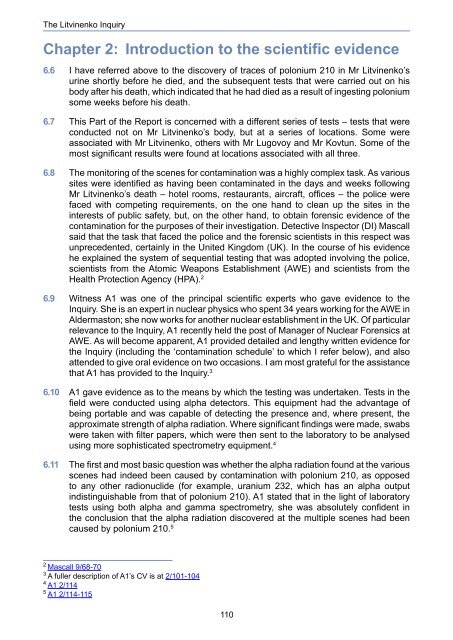The Litvinenko Inquiry
JIEp7Zyr
JIEp7Zyr
Create successful ePaper yourself
Turn your PDF publications into a flip-book with our unique Google optimized e-Paper software.
<strong>The</strong> <strong>Litvinenko</strong> <strong>Inquiry</strong><br />
Chapter 2: Introduction to the scientific evidence<br />
6.6 I have referred above to the discovery of traces of polonium 210 in Mr <strong>Litvinenko</strong>’s<br />
urine shortly before he died, and the subsequent tests that were carried out on his<br />
body after his death, which indicated that he had died as a result of ingesting polonium<br />
some weeks before his death.<br />
6.7 This Part of the Report is concerned with a different series of tests – tests that were<br />
conducted not on Mr <strong>Litvinenko</strong>’s body, but at a series of locations. Some were<br />
associated with Mr <strong>Litvinenko</strong>, others with Mr Lugovoy and Mr Kovtun. Some of the<br />
most significant results were found at locations associated with all three.<br />
6.8 <strong>The</strong> monitoring of the scenes for contamination was a highly complex task. As various<br />
sites were identified as having been contaminated in the days and weeks following<br />
Mr <strong>Litvinenko</strong>’s death – hotel rooms, restaurants, aircraft, offices – the police were<br />
faced with competing requirements, on the one hand to clean up the sites in the<br />
interests of public safety, but, on the other hand, to obtain forensic evidence of the<br />
contamination for the purposes of their investigation. Detective Inspector (DI) Mascall<br />
said that the task that faced the police and the forensic scientists in this respect was<br />
unprecedented, certainly in the United Kingdom (UK). In the course of his evidence<br />
he explained the system of sequential testing that was adopted involving the police,<br />
scientists from the Atomic Weapons Establishment (AWE) and scientists from the<br />
Health Protection Agency (HPA). 2<br />
6.9 Witness A1 was one of the principal scientific experts who gave evidence to the<br />
<strong>Inquiry</strong>. She is an expert in nuclear physics who spent 34 years working for the AWE in<br />
Aldermaston; she now works for another nuclear establishment in the UK. Of particular<br />
relevance to the <strong>Inquiry</strong>, A1 recently held the post of Manager of Nuclear Forensics at<br />
AWE. As will become apparent, A1 provided detailed and lengthy written evidence for<br />
the <strong>Inquiry</strong> (including the ‘contamination schedule’ to which I refer below), and also<br />
attended to give oral evidence on two occasions. I am most grateful for the assistance<br />
that A1 has provided to the <strong>Inquiry</strong>. 3<br />
6.10 A1 gave evidence as to the means by which the testing was undertaken. Tests in the<br />
field were conducted using alpha detectors. This equipment had the advantage of<br />
being portable and was capable of detecting the presence and, where present, the<br />
approximate strength of alpha radiation. Where significant findings were made, swabs<br />
were taken with filter papers, which were then sent to the laboratory to be analysed<br />
using more sophisticated spectrometry equipment. 4<br />
6.11 <strong>The</strong> first and most basic question was whether the alpha radiation found at the various<br />
scenes had indeed been caused by contamination with polonium 210, as opposed<br />
to any other radionuclide (for example, uranium 232, which has an alpha output<br />
indistinguishable from that of polonium 210). A1 stated that in the light of laboratory<br />
tests using both alpha and gamma spectrometry, she was absolutely confident in<br />
the conclusion that the alpha radiation discovered at the multiple scenes had been<br />
caused by polonium 210. 5<br />
2<br />
Mascall 9/68-70<br />
3<br />
A fuller description of A1’s CV is at 2/101-104<br />
4<br />
A1 2/114<br />
5<br />
A1 2/114-115<br />
110


